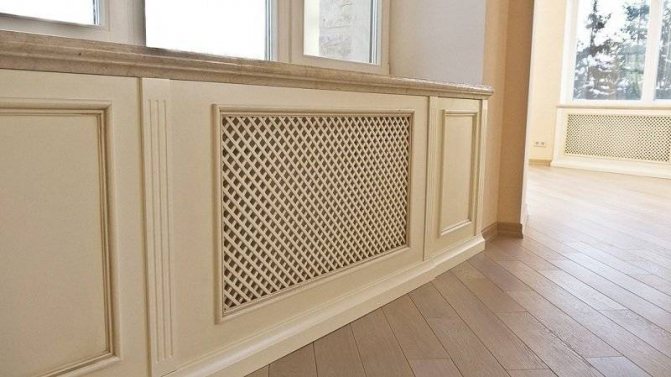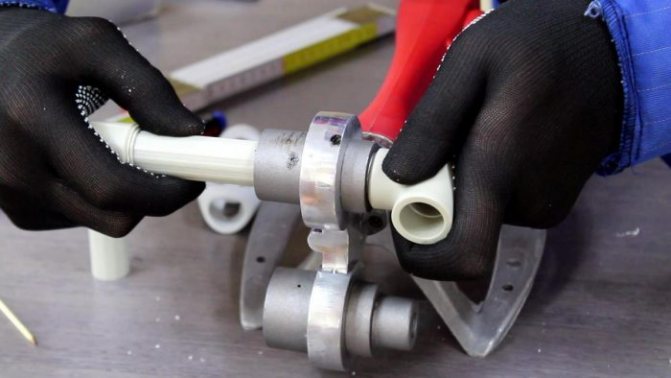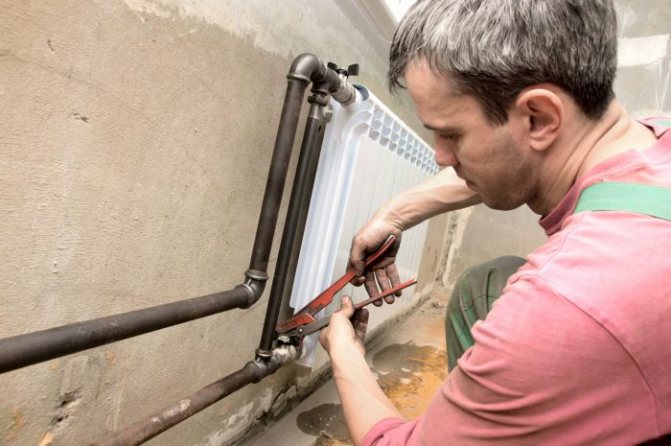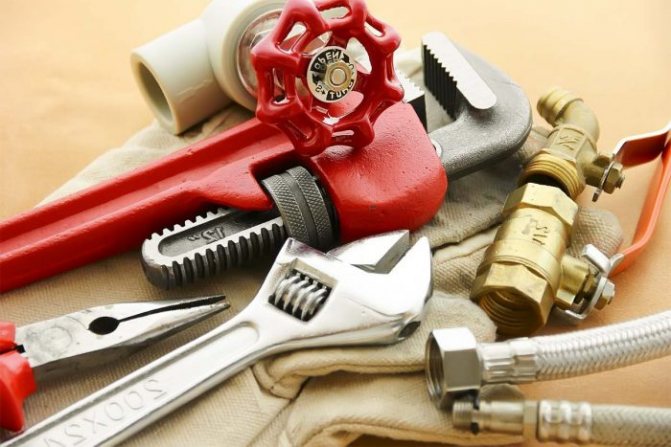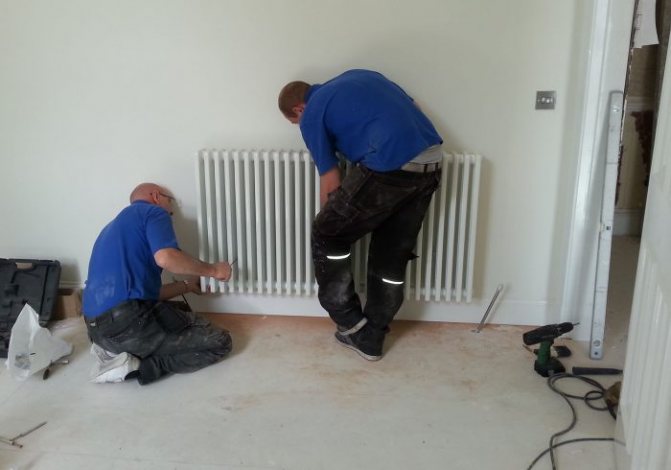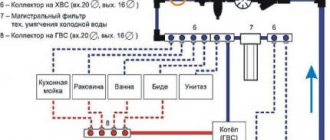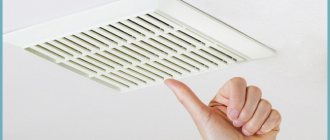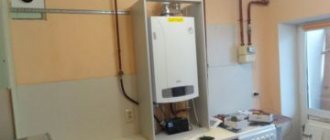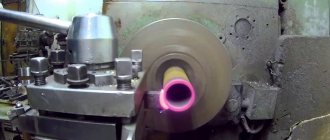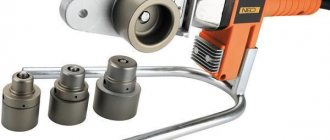Is it possible to hide heating in the walls?
Is it possible to hide heating pipes in the wall, many are interested. The described method has a lot of supporters and people with opposite opinions. Some argue that this cannot be done, others say that you can hide the heating in the wall.
So, is it still possible or not? Which opinion is correct, and what are the pros and cons of such decisions? And, in order not to keep the intrigue for a long time, you need to answer that this method can be used. And they use it very often.
This is an effective way to hide unsightly pipes in your home. There is no technical need for such actions, and in terms of functioning it is quite possible to do without it.
Consensus on this issue, as well as in the only correct option for laying, has not yet been found. Therefore, decision options, after weighing carefully all the pros and cons, everyone will take independently.
When is it necessary to change the heating pipes?
There are several reasons for replacement - the screw valve may be incorrectly installed, the thread has come off or broken, the radiator is leaky and drip.
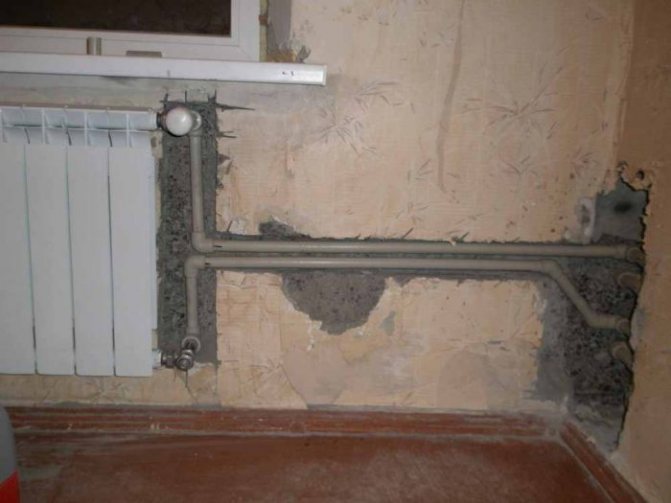
There are also defects in the system:
- layering of calcium deposits inside the line and a decrease in efficiency;
- air jams have formed in the system, and a Mayevsky crane is not provided;
- the wiring is old, does not meet the user's requirements, which is why it is cold in the house.
It is better to replace the entire system or its elements in the warm season, so neighbors will not complain about the lack of heating in the entire apartment building. But if the repair was required immediately (it became cold or the radiator is dripping), then the restoration is carried out at any time. In a private house, there are no such problems - disconnecting the heating from the boiler is possible at any time.
Hidden broach
Laying heating pipes in the wall is a fairly popular practice. This is justified by the fact that heating communications spoil the interior space very much. This is their big disadvantage. They stretch along the walls, catch the eye, and do not add attractiveness to the overall design. For these reasons, many want to hide them.
Heating can be installed in different ways, but the most common of them is wall mounting. At first glance, this is a very good solution, the pipe is completely hidden, the overall appearance of the room has improved a lot, but is everything really that simple, and what are the advantages of this solution?
Often, when laying a heating network in the walls, the joints lose their sealing. As a result, leaks are formed. It is impossible to see such places on a hidden pipeline, and defects can only be detected by a water pressure sensor.
All modern heating devices are equipped with such a device. When determining the leak, you need to establish the location of the accident, and make repairs.
If, after weighing all the pros and cons, and it is decided to lay the heating main in the wall, then the surface coating must be designed in such a way that access to possible emergency zones is free.
For these reasons, the cladding is made of plastic panels, lining, drywall, etc. The disadvantages of various decorative plastering are that in the event of an accident, the wall will have to be dismantled, and this is not only physical, but also financial costs.
Advice! When laying a polypropylene system with a hidden method, it is necessary to first test for strength. In this case, the test load must exceed the normal operating mode by at least 1.5 times.For metal systems, it is not recommended to use this method of laying, because of their significant disadvantage - poor resistance to corrosive formations.
You should also take into account one more nuance. The disadvantage of the plastic system is the linear increase during heating. When installing, this minus must be taken into account.
Features of installation of hidden heating pipes
If the method of installing pipes under the wall and floor remains a priority, then it is necessary to do it in compliance with some rules:
- It is worth taking care that access to communications is available at any time when it is required.
- It is necessary to choose quality pipes. Fiberglass pipes with internal reinforcement are usually chosen.
- It is necessary that every meter, the size of the slope in gravity systems was set from 0.5 cm.
These methods allow you to build the pipeline inside the walls. When laying out in a strobe, it is worth taking care of the turning zones of the system and connecting the bent elements correctly.
Important! If it is impossible to lay out at an angle, you need to buy and install a circular pump. It is also necessary for heating systems where there are more than 4 radiators.
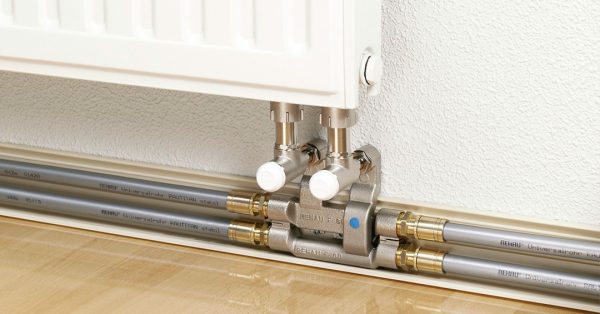

How to hide a heating network in an apartment - consider ways
Heating pipes can be hidden in panel walls in several ways. And there are not so many of them for this room. The first option in panel houses is the use of strobes, and the second way is the construction of false walls. Each of the options has pros and cons, and a decision for yourself must be made after a detailed study of these methods.
In the wall of a panel house, the heating pipe can be hidden when a new circuit is being assembled, or repair work is being carried out in an already functioning structure. As a rule, the wall of a panel house and the heating main are placed in different planes.
And when you need to bring them into one plane, recesses are cut in the panel walls and the heating main is placed there. With such actions, you need to focus on the following points:
- Before starting work in a panel house, the riser is blocked. You should not rush to perform these actions. And you should definitely make sure that the work is planned on the right riser.
- If the depth of the channel exceeds half of the partition thickness, then the best option would be to abandon the intended actions. So, for example, a bathroom in a panel house is a separate concrete block system. And the thickness of such panel walls for this task will be small.
- The dimensions of the grooves in the panel walls should not be close to each other, and they should not infringe on the contour. Deepening must be done with the calculation of the fasteners of the system, its volume and the insulating layer.
- Before covering the system in the wall of a panel house, it should be covered with insulation, otherwise condensation will form on the surface of the pipe.
- Before fastening the structure to the wall of a panel house, you need to determine its main places. These include joints and zones of change in the direction of the heat carrier.
To facilitate the action of chipping the wall in a panel house, it is recommended to use a grinder. First, markings should be made, and then, along the corresponding lines, the grooves are made to a certain depth level.


TIP! When working with a grinder, there is not only a lot of noise, but also dust. Modern tools have a big plus - the function of connecting to a construction vacuum cleaner, and this prevents the formation of dust.
According to existing rules, the communication network in the wall of a panel house should be located in an unobstructed access zone. Only those zones are left directly closed where the possibility of an accident is zero.
Hiding pipes in a private house
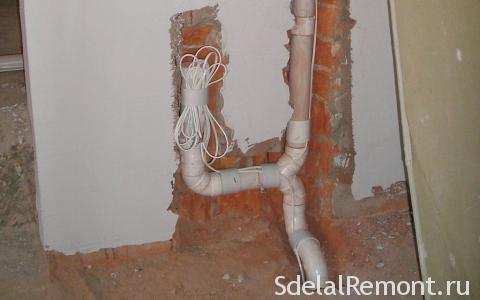

Making a shtrba in the kitchen
In a private house, undoubtedly, there are much more opportunities in terms of hiding pipes, but they often depend on the design features of the structure. If the base is a concrete floor, then the best option is to make the pipe part of the underfloor heating system. This does not even require a heat insulator for the pipelines. It is important here to carry out the correct insulation and screed base. It is imperative to lay a layer of expanded polystyrene; a damper tape should be laid around the perimeter of the room.
But if there is no need to make a heated floor, and the maximum efficiency of the heating system comes to the fore, then it is better to make grooves in the floor and lay pipes in them, after putting on thermal insulation. Foamed polyethylene or fiberglass composite half-sleeves are used today as it.
But before laying pipes in the walls and floor, it is necessary to draw up a project plan. It will help you correctly calculate the amount of materials and work out in advance the most rational ways to lay the heating main.
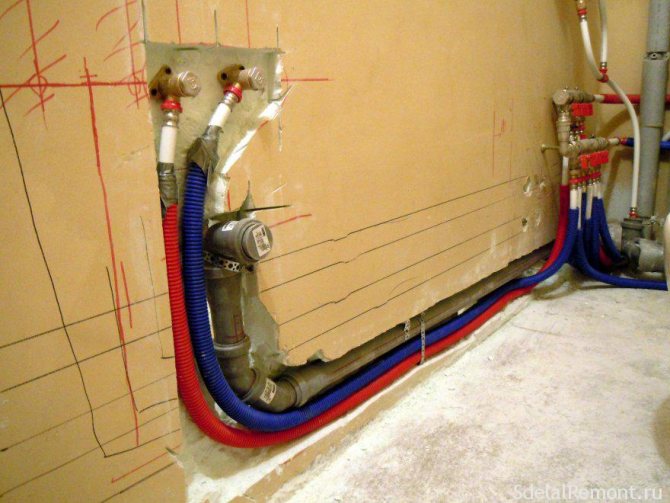

We make strobes for pipes in the bathroom
The grooves must be made with a 1 cm margin for the pipe size. This is necessary to put on the heat insulator and fill the space with a fastening solution. Further, the seam is closed by all known methods: preliminary leveling and topcoating. Fastening of pipes is carried out using clips or special brackets, which are mounted with dowels to the base.
When laying pipes in grooves, a wide variety of bypasses and bends will often be required, therefore, it is necessary to carefully think over the wiring of heating mains with all the nuances in advance. These are clamps, fasteners, contours and much more. After all, not everyone will be pleased to return to the store several times to buy the missing component.
There are a lot of ways to hide heating radiators and they depend both on the budget and on the style orientation of the design. For example, glass railings with an engraved image will look elegant. But it is also necessary to take into account the fact that small children can live in the apartment, so you should also choose the safest ways. Therefore, one of the safest, which can be used not only to hide heating pipes, but also all other plumbing in the bathroom, is a plasterboard pipe box.
Heating pipes under a false wall
Watch the video
If a decision is made to hide the heating pipes in a false wall, then in this case there are no special difficulties. First, a base is erected from guides, and at the end, it is decorated with any of the selected materials: clapboard, drywall, blockhouse.
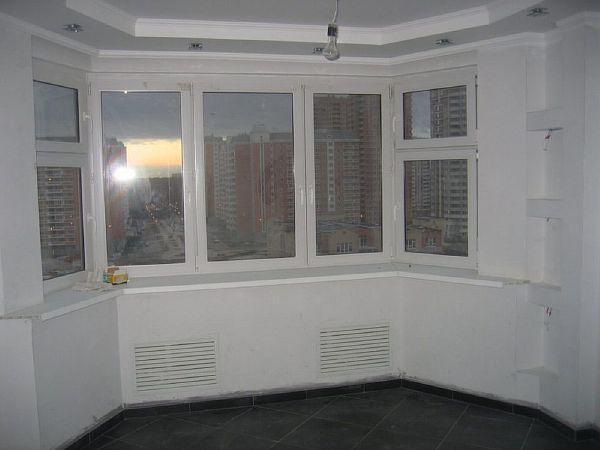

There is an opinion that if you hide the heating in a false wall, then the useful space of the housing is significantly reduced. Fortunately, this minus is only a myth. For example, if you need to hide the heating pipeline under the window, in reality this space is practically not used.
The only thing that is lost in this situation is incomplete fifteen centimeters under the windowsill, but it itself becomes wider by the same distance. This addition is much more useful than the unused area under the window.
If you need to hide unaesthetic designs of the heating system, then experts recommend a false wall. They call it just the perfect solution. A very important advantage of this building is that it can be designed without the participation of professional craftsmen. And this is a great advantage of this building.
In many situations, when it is necessary to hide the intersection of a horizontal and a vertical line, or to mount an overall system unit, the box may not always help out. But false - the wall in such situations to cope perfectly.
Another big advantage of this method is the excellent combination of construction with the overall design. When deciding to hide the heating pipes under a false wall, you can also reconsider the placement of other systems, for their decoration this method can also be effective.
How to hide heating pipes 3 simplest and most effective ways
An open pipeline is unlikely to be able to decorate any interior, so many people ask experts on the forums - how to hide heating pipes in an apartment or house so that the housing design looks more attractive? There are several options for solving this problem, which I will tell you about below.
An example of a hidden heating system
Pipe masking options
Among all the possible methods, the three most effective options for masking pipes should be distinguished:
Let's consider the features of each of these methods.
Option 1: hide pipes in the floor and walls
Before I tell you how pipes are walled up into walls or hidden in the floor, I will give several important rules that must be followed:
- only a new pipeline can be hidden in the floor or walls. Do not try to hide old highways, as problems may arise later;
- plastic pipes expand strongly under the influence of high temperature. This is especially true for polypropylene, the linear expansion of which reaches 5 mm per meter. Therefore, during the installation of the pipeline, it is necessary to provide for the required number of expansion joints;
- before you hide the heating pipes made of metal-plastic or metal, you need to put on heat-insulating casings on them, which will reduce heat loss;
- regardless of the material from which the pipeline is made, detachable fittings should not be walled up so that they remain freely accessible.
Concealed installation of pipes in walls
The process of laying pipes into walls is carried out in the following sequence:
- first of all, you need to draw up a wiring diagram and, in accordance with it, mark the location of pipes on the walls;
- then, according to the marking, you need to make the channels with your own hands. To do this, you can use a perforator with a chisel included in the impact mode;
- to securely fix the pipes in the grooves, holders or brackets are installed. To install the latter, you should use the dowel-nails;
- then heat-insulating casings are put on the pipes, which can be fixed with plastic clamps, after which the pipeline is installed in the grooves;
- after assembling the heat pipe, it must be pressurized (checking work under pressure), which makes it possible to identify leaks and immediately eliminate them;
- at the end of the work, the grooves are sealed with cement mortar. For better adhesion of the composition, they must first be cleaned of dust and primed.
The grooves must be carried out taking into account the thickness of the insulation and the mortar for embedding.
Installation of a heat conductor in the floor
It is even easier to hide the heat pipe in the floor. As a rule, pipes are laid on the base before screed, after which they are poured with concrete. At the same time, heat-insulating covers are used in the same way, and the system is necessarily pressurized.
If it is not planned to pour a screed on the floor, the pipes can be laid in the space between the joists and the rough covering. To beautifully decorate the place where pipes enter the floor and exit, use special pipe linings.
I must say that after the installation of the pipeline, it is imperative to draw up an executive diagram on which the locations of the pipes are indicated. This is necessary in order not to violate the integrity of the heating system in the process of subsequent home repairs.
Example of a box for a riser
Option 2: mount the frame
Installation of a heat pipe in grooves is the most optimal solution. However, if the system is already mounted, then it can only be hidden with the help of a box.You can make the latter from the following materials:
To make a box, you need to prepare the following materials and tools:
Box
Performing modern high-quality repairs, we hide the heating pipes in the wall. This installation option requires careful calculation and drawing up a detailed diagram. If they hide the heating network at the stage of building a house, then the task is not difficult to complete.
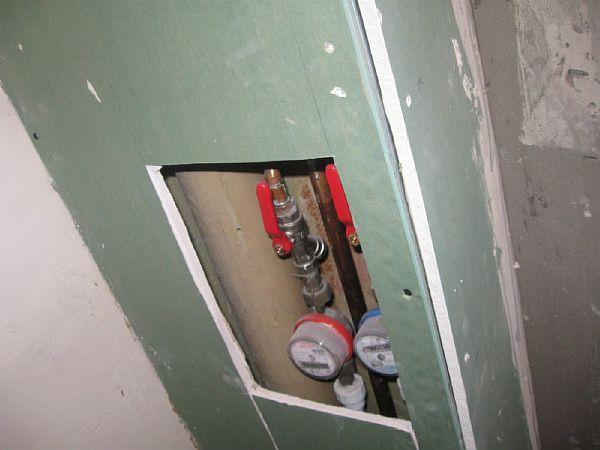

But, with an already operating pipeline stretched along the walls, they do this. In addition to false - the walls can be sewn up with a box. At the same time, a frame is assembled from wooden boards or from a profile, which is subsequently sheathed with various materials suitable for design. Neither the construction nor the cladding of the frame presents any particular difficulties.
If we hide pipes in a box, and not in a wall, then the advantages of this option speak for themselves. The structure is not difficult to build, with a small financial investment. Also, a clear advantage of such a construction is the ability to quickly get to the nodes for repair work.
Watch the video
If they hide the highway under a box without openings, then this also does not constitute big problems, so this building is easily dismantled, and then it also returns to its original place. And one more important nuance cannot be ignored. When they hide the heating main under the box, then such a building acts as a decor detail that can be decorated to your liking.
Isolation is or may not be done
The transfer of heating pipes to the wall involves the use of insulation. Many people pose a completely justified question: "Why is this insulation needed when transferring pipes under plaster?" The answer is simple, otherwise the heat will go into the walls for warming up.
Most of the heat is lost in the walls that are in contact with the street. In the inner walls, the problem of heat loss is not big, since heat will still go into the room, but its amount will be slightly less.
Carrying out the transfer of the heating pipeline to the wall, they carry out not only thermal insulation. This creates an obstacle to the formation of condensation. After all, any moisture is a favorable soil for the development of a fungus.
It is also important to note that insulation during the transfer of heating pipes has another important function. It protects the line from mechanical stress.
Watch the video
When choosing an insulation option when transferring a pipeline, it is important to take into account that each of the proposed materials has its own pros and cons. For example, polyurethane foam should be taken with the lowest thermal increase, in the case of polyurethane foam, a material should be taken that exactly matches the size of the system, etc.
How to fix the pipeline
Heating pipes are laid in the wall with various devices. Let's consider several options:
- sliding;
- hard.
The immovable support for the pipeline holds the structure "tightly". With this arrangement, the contour cannot be displaced. And when laid with sliding fasteners, it can move a little. When broaching the line, these two types of fasteners are recommended to alternate.
Types of fasteners that are used when laying the network under plaster:
- Metal clamps. These are fairly simple devices in which fixation is carried out by tightening the bolt.
- Clip. These devices are also simple in design. The advantage of such a device is that the fixation is performed with one click.
- Retractable plastic clamps. Unlike their metal counterparts, such pipeline laying devices are equipped with only one fixing point.
- Dowel - hook. These options are recommended for laying the system on a flat surface. Such a screw is tightened or carefully hammered into the prepared place.
- Crab - systems.These mechanisms are used when fixing the pipeline to the walls, and for fastening the highways to each other.
Pros and cons of this type of gasket
Professionals are inclined to believe that installing heating pipes into the wall is not an easy and expensive procedure.
It is difficult to name the objective advantages of such actions, apart from the aesthetic design. But, the disadvantages in this situation are obvious.
- The most important thing is the complexity of the installation. Before starting work, it is important to take into account that it is difficult to dock the parts. It is especially difficult to perform high-quality welding in grooves.
- There is a high likelihood of leakage. With such an installation, in the event of an accident, you will have to break the wall.
- The whole range of installation work in this case is associated with high physical and financial costs. And this is a very significant disadvantage of this installation option.
Watch the video
Use of decoration
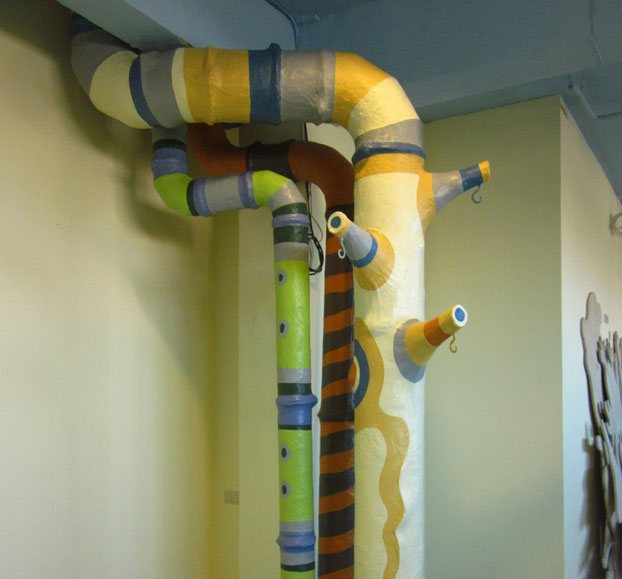

There are a lot of options to decorate heating pipes and other communication pipes without stitching them into boxes, walls, floors or ceilings. You can decide on any one, based on the general concept of finishing the premises.
In the kitchen, for example, you can simply paint the riser in the color of the wall decoration. This may not be very expressive from the point of view of aesthetics, but this type of finish will ensure the moisture resistance of the pipe and its endurance to temperature shocks, and also guarantee absolute safety for human health.
Important: For this kind of finish, you should choose high-quality paint. And paint only a cold contour - on a hot one, the composition will dry quickly and will crack almost immediately.
An excellent option for finishing "unhidden" pipes is special screens. They work great in kitchens and bathrooms as well as toilets. You can independently make such screens from wood or plastic, MDF or metal sheets. And you can buy ready-made, since today in specialized stores selling building materials and related products, a huge selection of similar parts (various colors and patterns, different shapes and sizes).
Installation of purchased screens is a matter of a few minutes. And this is one of the simplest finishing operations. You just need to install the elements in the right places, and then use a special mount, and the pipes will be closed nicely and securely.
However, such screens also have to be chosen. And not only "to taste". You need to look at their performance. It is important that the screen is perforated and allows air circulation in the room. In addition, you need a guarantee of maximum heat transfer from the riser, etc. As for the aesthetic side of the issue, you can choose stained-glass or backlit screens if the interior design requires it.
Another option is heating pipes placed under the ceiling. You can decorate them with cornices, as well as wrapping them with textiles, ribbons, twine, etc.
In any case, heating and utility pipes should not remain an object that spoils the interior, even if we are talking about a bathroom. They should either be hidden, or harmoniously support the interior, or be played out in an original way as an expressive decorative element.
(82 voice., middle: 4,70 out of 5)
Do-it-yourself wall insulation outside: technologies and recommendations
Installation of Armstrong suspended ceilings: calculation, fastening, assembly
Similar posts
Moving a plastic riser into a wall
Such a system is much easier to hide in the wall, no need to resort to welding, just make threads on the pipe. Corrosion does not threaten such a riser. Plastic pipes will last for a long time. But there are also disadvantages. Polypropylene pipes are characterized by very high rates of thermal expansion. And therefore, such heating systems, as a rule, are equipped with ring-shaped or U-shaped bends, but being in the wall, polypropylene will not be able to expand.Consequently, polypropylene pipes, which have limited strength when changing temperature and pressure in a central heating system, are not the best option for heating risers.
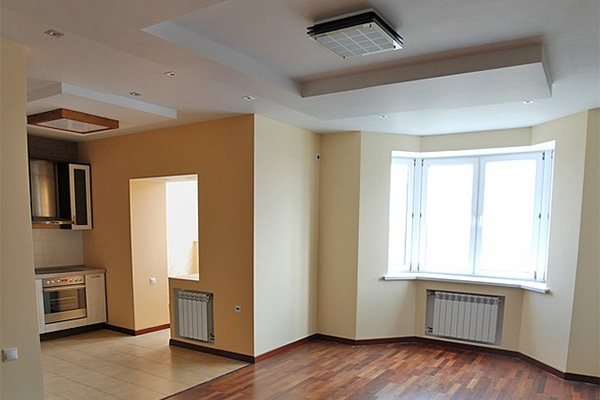

Advantages and disadvantages
To be honest, laying heating pipes in a concrete wall is nonsense. The question is why? What is the purpose of this complex, costly and risky procedure?
Of the advantages of bricking heating in a wall, one cannot call objective ones. But the disadvantages are obvious:
- complex installation. Before laying heating pipes in the wall, think about the fact that it is very inconvenient to connect the elements. It is extremely difficult to solder metal communications in a high-quality manner;
- risk of leakage. At the same time, in order to eliminate the leak, you will have to break the entire wall, not to mention the fact that it is almost impossible to determine the place of the leak in person if there is no wet spot on the wall;
- the need to perform complex, time-consuming processes, such as installing heating pipes in the wall.
If you decide to hide communications in concrete walls, you better think a little more, maybe this idea will pass by itself. A false wall is another matter:
- convenient access to key system nodes;
- wide window sills;
- saving money and time.
Summing up, let's highlight the main points. Firstly, there is no need to muck communications into concrete walls; it is better to hide them behind a false wall. Secondly, it is necessary to insulate the pipes and thirdly, to securely fasten them with the help of special clamps and clips.
